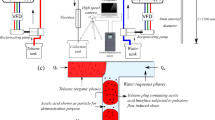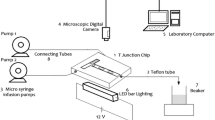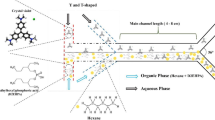Abstract
The droplet flow regime in microchannels can increase the mass transfer and chemical reactions considerably. In this work, the mass transfer of immiscible fluids of water as the solvent and butyl acetate containing 5 vol% of acetic acid as the feed is experimentally studied in a vertical flow inside a microchannel with the inner diameter of 8 mm. Effect of total flow velocity, Re number and volumetric flux ratio of two phases (Qaq/Qor) on the extraction fraction of acetic acid, mass transfer coefficient and droplet size were investigated. Based on the experiments, increasing the flux ratio can shift the flow regime from the plug to the droplet. Compared to the plug flow, the extraction fraction increased by 2–3 times in the droplet regime, depending on the total velocity, while the average diameter of the droplets decreased. Moreover, with the increase in the total velocity, the extraction fraction is reduced by 22%. However, in the case of the plug flow, the extraction fraction does not change appreciably with the increase in the total flow velocity. The mass transfer coefficient was found to increase monotonously with increasing Re number and an enhancement of 133% was achieved in the droplet flow regime.








Similar content being viewed by others
References
Tang J, Zhang X, Cai W. Liquid–liquid extraction based on droplet flow in a vertical microchannel. Exp Therm Fluid Sci. 2013;49:185–92.
Amani P, Amani M, Ahmadi G, Mahian O, Wongwises S. A critical review on the use of nanoparticles in liquid–liquid extraction. Chem Eng Sci. 2018;183:148–76.
Bäumler K, Wegener M, Paschedag AR, Bänsch E. Drop rise velocities and fluid dynamic behavior in standard test systems for liquid/liquid extraction-experimental and numerical investigations. Chem Eng Sci. 2011;66:426–39.
Azizi Z, Rezaeimanesh M, Tohidian T, Rahimpour MR. Dimethyl ether: a review of technologies and production challenges. Chem Eng Process. 2014;82:150–72.
Lee CY, Fu LM. Recent advances and applications of micromixers. Sens Actuators B Chem. 2018;259:677–702.
Azizi Z, Alamdari A, Malayeri MR. Convective heat transfer of Cu–water nanofluid in a cylindrical microchannel heat sink. Energ Convers Manage. 2015;101:515–24.
Hemmat Esfe M, Saedodin S. Turbulent forced convection heat transfer and thermophysical properties of MgO–water nanofluid with consideration of different nanoparticles diameter, an empirical study. J Therm Anal Calorim. 2015;119:1205–13.
Azizi Z, Alamdari A, Malayeri MR. Thermal performance and friction factor of a cylindrical microchannel heat sink cooled by Cu–water nanofluid. Appl Therm Eng. 2016;99:970–8.
Toghraie D, Abdollah MMD, Pourfattah F, Akbari OA, Ruhani B. Numerical investigation of flow and heat transfer characteristics in smooth, sinusoidal and zigzag-shaped microchannel with and without nanofluid. J Therm Anal Calorim. 2018;131:1757–66.
Arabpour A, Karimipour A, Toghraie D. The study of heat transfer and laminar flow of kerosene/multi-walled carbon nanotubes (MWCNTs) nanofluid in the microchannel heat sink with slip boundary condition. J Therm Anal Calorim. 2018;131:1553–66.
Joseph John J, Kuhn S, Braeken L, Van Gerven T. Effect of fluid properties on ultrasound assisted liquid–liquid extraction in a microchannel. Ultrason Sonochem. 2018;42:68–75.
Singh KK, Renjith AU, Shenoy KT. Liquid–liquid extraction in microchannels and conventional stage-wise extractors: a comparative study. Chem Eng Process. 2015;98:95–105.
Joseph John J, Kuhn S, Braeken L, Van Gerven T. Ultrasound assisted liquid–liquid extraction in microchannels—a direct contact method. Chem Eng Process. 2016;102:37–46.
Xu JH, Tan J, Li SW, Luo GS. Enhancement of mass transfer performance of liquid–liquid system by droplet flow in microchannels. Chem Eng J. 2008;141:242–9.
Su Y, Zhao Y, Chen G, Yuan Q. Liquid–liquid two phase flow and mass transfer characteristics in packed microchannels. Chem Eng Sci. 2010;65:3947–56.
Zhao Y, Chen G, Yuan Q. Liquid–liquid two-phase flow patterns in a rectangular microchannel. AIChE J. 2006;52:4052–60.
Darekar M, Sen N, Singh KK, Mukhopadhyay S, Shenoy KT, Ghosh SK. Liquid–liquid extraction in microchannels with Zinc-D2EHPA system. Hydrometallurgy. 2014;144:54–62.
Yadav RL, Patwardhan AW. Design aspects of pulsedsieve plate columns. Chem Eng J. 2008;138:389–415.
Azizi Z, Rezaeimanesh M. Packing effect on mass transfer and hydrodynamics of rising toluene drops in stagnant liquid. Chem Eng Res Des. 2016;115:44–52.
Rahbar A, Azizi Z, Bahmanyar H, Moosavian MA. Prediction of enhancement factor for mass transfer coefficient in regular packed liquid–liquid extraction columns. Can J Chem Eng. 2011;89:508–19.
Azizi Z, Rezaeimanesh M, Abolghasemi H, Bahmanyar H. Effective diffusivity in a structured packed column: experimental and Sherwood number correlating study. Chem Eng Res Des. 2014;92:43–53.
Azizi Z. Experimental investigation of terminal velocity and Sherwood number of rising droplet in an extraction column. Heat Mass Transf. 2017;53:3027–35.
Saien J, Daliri S. Improving performance of liquid–liquid extraction with temperature for mass transfer resistance in both phases. J Taiwan Inst Chem Eng. 2014;45:808–14.
Drelich J, Fang C, White CL. Encyclopedia of surface and colloid science. 3rd ed. New York: Dekker; 2015.
Author information
Authors and Affiliations
Corresponding author
Electronic supplementary material
Below is the link to the electronic supplementary material.
Supplementary material 2 (MP4 4434 kb)
Supplementary material 3 (MP4 3177 kb)
Supplementary material 4 (MP4 7166 kb)
Supplementary material 5 (MP4 1691 kb)
Rights and permissions
About this article
Cite this article
Azimian Fereydani, A., Azizi, Z. Experimental study of extraction fraction and mass transfer coefficient in a microchannel using butyl acetate/acetic acid/water chemical system. J Therm Anal Calorim 133, 945–950 (2018). https://doi.org/10.1007/s10973-018-7360-2
Received:
Accepted:
Published:
Issue Date:
DOI: https://doi.org/10.1007/s10973-018-7360-2




